Petzl RAD System Review
The Petzl RAD System (Rescue and Descent) is designed for skiers to rapidly perform crevasse rescue, rappelling or roping up to travel in glaciated terrain. The system consists of three tried & true Petzl devices; a Micro Traxion Hauling Pulley, a Tibloc and screwgate carabiners, and also adds a 6mm x 30m RAD Line, which forms the heart of the system. I couldn’t find any information on the RAD Line, but it appears to be some sort of thin static line with a nice tie-able sheath on it.
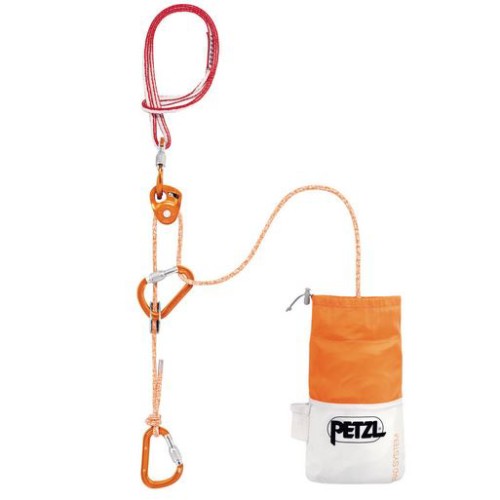
The Petzl RAD System. Photo: Petzl
The true beauty of this system is that it is so compact and lightweight that you can always take it with you without incurring a big weight and bulk hit as happens with a traditional glacier rope and rescue kit. I had a chance to use the RAD System in Alaska last week and carried it with me 100% of the time, whereas with a standard system, the rope and glacier kit is one of the first things to get left behind if you find yourself in “safe” terrain. I fortunately never had the chance to set it up for a crevasse rescue, but just by looking at it, it obviously has all of the components of a Z-drag system, minus the complexity of rigging one.
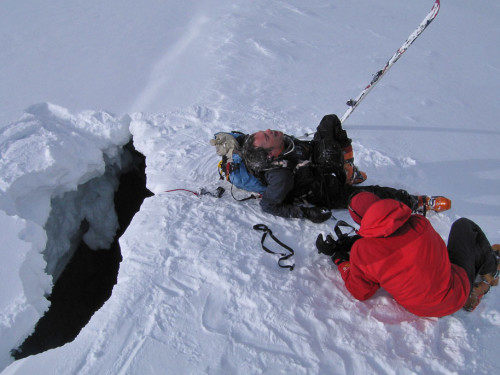
This photo of Ben Ditto and Grant Guise had a happy ending even though we had left the ropes 1,000′ below on the glacier. This crack was right near the summit.
I haven’t seen any test data on using a skinny static line for glacier travel, but from practical experience I can understand the theory. Unlike vertical rock climbing which uses friction belay devices and set protection, glacier travel uses running belays (a group of skiers tied together) and the system gets some of its dynamic loading from the rope cutting into the snow. Static lines are akin to steel cables and should never be used for belayed vertical climbing, but for glacier travel, they seem perfect. This detail is the one major caveat of the RAD System – it is a dedicated, specific use product which requires another acronym to safely use it: RFI (Read the F’ing Instructions).
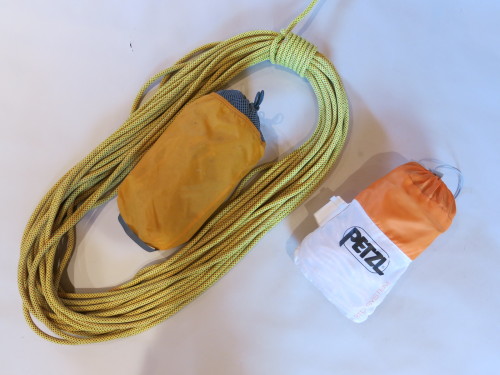
Side-by-side comparisons of a traditional glacier package (left) and the Petzl RAD System.
The system comes pre-rigged from Petzl, but it is easy to uncouple the parts and use the RAD Line as a stand-alone glacier rope. One of the more unnerving things to get use to is how small the knots are when using a 6mm cord. On a standard 9.2mm rope a Figure 8 knot is the size of a fist, whereas with a 6mm it is about the size of two fingers. An added benefit of this is that small knots take up less length, so you can spread out a bit (yes, true, a very little bit) more on a 30m line when traveling.
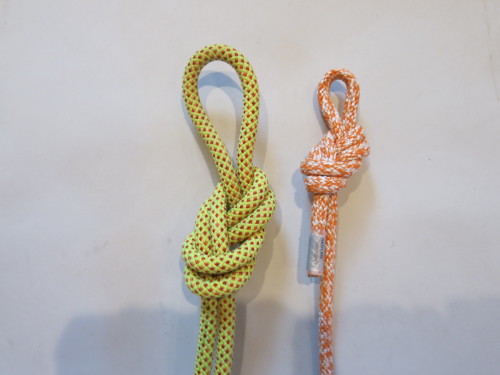
Tiny little mouse sized knots take some getting used to…
The RAD System if due out in July 2015 and although I have no idea what the price will be, it’s the type of product that quickly pays itself off with each step you take.
________________________________
Help support StraightChuter.com and be prepared for an emergency rope ascent with a Petzl Tibloc Ultralight Emergency Ascender from Backcountry.com. Click on the photo below.
Category: Gear Reviews

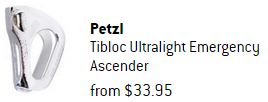








Are the tiblocs the same as your run of the mill tibloc or specially designed for smaller diameters? Also would love to know more about the rope if you find out any more… I have some 5.5mm dyneema core stuff that I’d like to make a similar kit with…
Interesting. Have you ever had any trouble with a tibloc chewing rope? And how did you get the fellow out without a rope?
Hi Josh – These are just standard issue Tiblocs. I don’t know if they’d work with a 5.5mm ??? The 5.5mm I have has a very tight sheath, so I don’t know if it would work, but the Petzl RAD Line seems a bit thicker and softer.
According to the Petzl website the micro traxion is only useable on ropes down to 8mm. I wonder how they remedy this.
When it comes to glacier travel I like to try to keep the rope tight to minimize a crevasse fall. This makes self-rescue ― climbing up the rope ― that much easier. I find this to be the better option, as opposed to being hauled out by others (possible injury of being pulled through the lip).
So, I can see how it can operate as a Z-pull, but can it be used for self-rescue?
And is this the entire kit? Does only one person carry the kit (that is with everyone tied into the rope who carries the rest of the parts and what happens if they are the one to fall in the hole), or does everyone need to carry a kit? If so, is any weight saved?
Always looking for better ways to do things. Thanks for the review.
Following up on Darren’s comments I’m also not clear if the RAD is intended to replace a traditional glacier setup with rope and tackle, or act as an additional line for rescue purposes only. Will you be replacing your whole glacier kit with this setup Andrew? If yes, what spacing will you use for tie in?
Hi Darren – Yes, keeping the rope tight, or at least slack out of the system is the A #1 way to avoid a big crevasse fall. I’ve had lots of holes crack under my feet, but by keeping the rope tight, I’ve never taken the plunge, nor have any of my ropemates. With this system, if you go fall into a crack, you can still self rescue with prussick loops just like any other roped fall.
With the RAD system, I guess who carries what and how much would really depend on the group. In my most recent case where I was guiding, I was the only person who carried it as I was the only person who knew how to set up a snow anchor in the first place. I guess if you are with a group of experienced people they could all carry a Micro Traxion/Tibloc, or more likely just a traditional Z-drag kit.
If using this kit, wouldn’t one need to use prusik loops made from thinner accessory cord than when using traditional-width rope?
Hi Travis – Like all things skiing related… it depends. A 30m skinny static line is definitely specialized and wouldn’t work if you needed to do any climbing or really space out on a rope while traveling, but for a lot of glacier travel I think it would be fine. For spacing out, that again depends. In safe terrain and good weather I’ll often run 5 people on a 30m rope.
Is the system burly enough to adapt for roped ski cuts? Or would that compromise it’s reliability?
Hi imelr – Personally, I’d say it was plenty adequate for roped ski cuts, but the issue there would be creating a belay device which works well with that thin of a cord.
Andrew have you tried the Rescueme? I like mine a lot.
http://www.skipass.com/news/119000-chute-dans-une-crevasse-strahlhor.html
There is some good information from Petzl about the use of the RAD system.
http://www.petzl.com/en/Sport/Ropes/RAD-SYSTEM?l=US#.VX3CVTBViko
check out the technical information and product experience sections. Their testing seems to indicate that the RAD line can be easier to arrest a crevasse fall than a thin dynamic rope because of its static properties.
On the subject of appropriate rope diameters in tiblocs and micro traxions they have tested the RAD line with them. They can’t guarantee that other cords outside their specified size ranges will work. This was from talking with a Petzl rep.